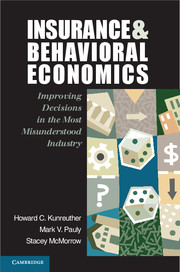Book contents
- Frontmatter
- Contents
- Preface
- Acknowledgments
- Part I Contrasting Ideal and Real Worlds of Insurance
- 1 Purposes of This Book
- 2 An Introduction to Insurance in Practice and Theory
- 3 Anomalies and Rumors of Anomalies
- 4 Behavior Consistent with Benchmark Models
- Part II Understanding Consumer and Insurer Behavior
- Part III The Future of Insurance
- Notes
- Glossary
- Bibliography
- Author Index
- Subject Index
3 - Anomalies and Rumors of Anomalies
Published online by Cambridge University Press: 05 February 2013
- Frontmatter
- Contents
- Preface
- Acknowledgments
- Part I Contrasting Ideal and Real Worlds of Insurance
- 1 Purposes of This Book
- 2 An Introduction to Insurance in Practice and Theory
- 3 Anomalies and Rumors of Anomalies
- 4 Behavior Consistent with Benchmark Models
- Part II Understanding Consumer and Insurer Behavior
- Part III The Future of Insurance
- Notes
- Glossary
- Bibliography
- Author Index
- Subject Index
Summary
The classical approach to economics tends to elegance and simplicity, as we saw in the benchmark models of supply and demand. The outcome of a competitive insurance market generally means resources are allocated efficiently and outputs are produced at lowest cost; consumer welfare is maximized, given the resources available to the economy. The only reason for intervention by the public sector is to correct any inequities from the resulting premiums, such as providing some type of subsidy to low-income residents currently residing in hazard-prone areas who cannot afford homeowners’ insurance or to low-income households that might fail to buy health insurance without financial assistance.
But the real world is a considerably messier place. Individuals have difficulty understanding the purposes and concepts of insurance; firms often do not provide coverage at premiums that reflect risk. This chapter presents and analyzes anecdotal evidence of unusual insurance behavior reported by the media. Few of these journalistic examples use benchmark economic models to measure alleged mistakes by consumers considering buying insurance or insurers determining whether to offer coverage against a particular risk.
- Type
- Chapter
- Information
- Insurance and Behavioral EconomicsImproving Decisions in the Most Misunderstood Industry, pp. 32 - 50Publisher: Cambridge University PressPrint publication year: 2013



